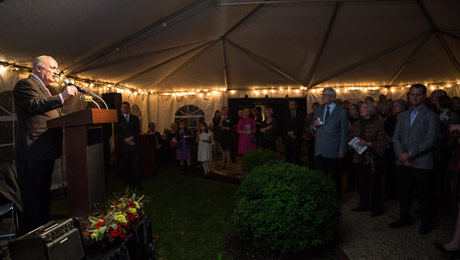Nearly 450 guests gathered at The Textile Museum on S Street Friday for “A Night to Remember,” celebrating the institution’s 88-year history as it prepares to move to the George Washington University.
At GW, The Textile Museum will become the cornerstone of a new university museum, set to open next fall. The current home of The Textile Museum, in two century-old buildings once owned by museum founder George Hewitt Myers, closed its final exhibition on Sunday.
“While we are here to bid this beloved spot farewell, tonight is truly a celebration of Textile Museum friends and family, our long history and exciting future,” Bruce P. Baganz, president of The Textile Museum’s Board of Trustees, told the gala audience. “And we look forward to being at the George Washington University by this time next year, with a grand, special purpose-built museum specifically designed around the needs of The Textile Museum.”
The Textile Museum will have more than double its current exhibition space with the museum and Woodhull House’s combined 46,000 square feet. The university is also constructing a facility on its Virginia Science and Technology Campus that will offer 22,000 square feet of climate-controlled space in which to store and study the museum’s more than 19,000 pieces of carpets, clothing and other textiles that span 5,000 years of history.
“For all of you who love The Textile Museum … to reflect on the 88-year history of this house must make this something of a bittersweet moment. You are leaving shortly an historic home,” Steven Knapp, president of the George Washington University, said in an address at the closing reception. “But I have to say I’m extremely excited, as are all my colleagues, about what lies before us with a partnership that will provide unparalleled intellectual and cultural opportunities for our students, for our faculty and for visitors from around the world.”
Jan Sponberg, a visitor to the museum for the past decade, came to view its pieces to reconnect with her travels in Asia, where textiles were an important part of the culture and her experiences there. She said she feels that the move is beneficial for The Textile Museum.
“In just a month I’ve learned why this building has been home to so many people,” said Lauren Shenfeld, B.A. ’13, who has been working with the museum during the first year of her master’s program in museum studies as a presidential administrative fellow. But she added that she’s already thinking about ways to engage students after the move.
Ashlee Forbes, B.A. ’12, said she thinks great opportunities will be available to students by having the museum on campus.
Ms. Forbes shared stories about her volunteer experience at the museum in a video booth at the event. Others wrote down memories of the museum in a guest book and on a memory board. In addition to these opportunities to send best wishes for the museum’s future, guests were also able to view the “Out of Southeast Asia: Art That Sustains” exhibition in its final weekend. Tours were given throughout the night for small groups of visitors to parts of the museum rarely seen by the public.
One tour showed the administrative offices of the museum and, thanks to insights provided that day by Myers’ grandchildren, relayed the uses of these repurposed rooms when they served as the Myers’ home.
Another tour took place in the space where conservation and collections management staff have been working since January 2012 to prepare the museum’s pieces for transport. According to The Textile Museum Registrar Rachel Shabica, nearly half of the artifacts require some type of work before the move. Sometimes the work is as simple as moving a piece from one box to another. In other cases, a piece may need a custom mount of tissue paper and cardboard framing to reduce direct handling of the object in the future. The pieces, as a standard precautionary measure, will be frozen to kill any pests the textiles may encounter during the move.
Ms. Shabica said organization, planning and thinking through the process have been crucial in preparing for the massive undertaking, and that she's confident the move will go smoothly.
As John Wetenhall, director of the GW museum, told an audience of museum supporters at “A Night to Remember,” it’s not just the textiles that are moving to campus.
“This means more than moving collections,” Dr. Wetenhall said. “It encompasses the visionary mission of our founder, George Hewitt Myers; decades of history, exhibitions and scholarship; and most of all a community of loyal partners, experts, staff, committed docents and volunteers, and dedicated members and friends from the neighborhood and from around the world. This community, you have shaped our museum, and we must carry your support with us as we bring life to the new museum at the George Washington University.”


